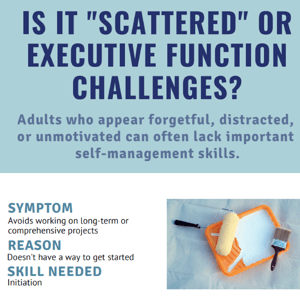We are living in an unprecedented time. As easy as  it is to become overwhelmed amidst the chaos, there are things we can do to take control of the world around us in order to bring about a sense of security and calm. One of the most effective steps we can take to do this is by first getting a grip on our organizational skills. With so many of us being stuck at home, this may present the perfect opportunity to do so (spring cleaning, anyone?).
it is to become overwhelmed amidst the chaos, there are things we can do to take control of the world around us in order to bring about a sense of security and calm. One of the most effective steps we can take to do this is by first getting a grip on our organizational skills. With so many of us being stuck at home, this may present the perfect opportunity to do so (spring cleaning, anyone?).
Where Do I Start?
The first step in any project is to establish a purpose. Start by making a list of all of the things you want to organize. Once you've done that, look over the list and break larger spaces down into more manageable chunks. For example, the kitchen may be split into areas such as the refrigerator, the pantry, cabinets, drawers, etc. From there, it's important to prioritize which spaces are most important to you before selecting one to start with. I recommend choosing something small that you can complete from beginning to end in one sitting. The kitchen junk drawer perhaps? Whatever that may be for you, make the decision and take a “before” picture and send it to a close friend or family member for added accountability. This will solidify the starting point and allow you to move forward, while also getting an extra bit of motivation to finish the job.
Clear Out and Do a Rough Sort
Next, clear everything out of the space. As you are removing items, do an initial rough sorting. I suggest having piles pre-labeled for items that will be kept, relocated, donated, or thrown away. Go through everything as you are clearing out the space and decide where it belongs. Remind yourself what the function of the space actually is, and ensure that anything that is in the “keep” pile serves that purpose. Items that need to be relocated are things that you want to keep, but do not belong in that place. Rather than taking the time to find new homes for these items in the moment, which will most likely cause you to become distracted and lose sight of what you are trying to accomplish, determine a designated spot for them for now. You can return everything to its rightful spot when you are finished!
Categorize and Purge Like Crazy
After the rough sort, it is time to go through all of the items in the “keep” pile another time. For this second look, really think about each item’s purpose and whether or not it is a necessity. Toss anything that is not useful or has expired. This may seem obvious, but it can be hard to throw out papers that may potentially be important. In those tricky cases, determine whether or not that particular item could be easily retrieved online, and consider whether or not a physical copy is even practical (instruction manuals or shopping receipts are good examples of this). Taking a picture of a sentimental item or donating it to someone else can also be helpful. Remember - this process is meant to be positive and cleansing, so if you know you're going to be upset or stressed over tossing something, remember that you don't necessarily have to get rid of everything.
As you go through the items, group them by placing similar items together. As the categories begin to emerge, think about simple storage solutions. Before you make a new purchase, consider if something you already have would work. Maybe there are some empty bins in your garage that could be repurposed? Or, perhaps that cardboard box lid could function as a temporary organizer in a drawer? Sometimes it may be necessary to invest in something that will make the space more functional, but it's always good to make that decision mindfully.
Organize and Refill the Space
Now for the fun part - putting it all back together! Start by cleaning and wiping down the space so that it is ready to be set up. As you put things back, keep similar items together. Make sure the things that you use most often are accessible and up front, while items that are used less often go in the back or on a higher or lower shelf. Consider containing small or loose items in a ziplock bag or a Tupperware container. Like many other things in life, organizing is a process that requires effort and time to maintain. Habits take time to create, but taking the first step is often the hardest part.
Celebrate Success
No matter how small, celebrating success is a critical part of this process, and reframing how we see little victories in the context of this pandemic is another key way to build confidence from the experience. Take time to reflect on the fact that you accomplished your goal, and observe how this new, organized space makes you feel - because chances are, it makes you feel pretty amazing! Being mindful of this feeling will help maintain the motivation you need to keep the space organized in the long term. Also, be sure to reward yourself with an incentive for all of your hard work. Take an “after” picture and share it with your accountability person, inviting them to celebrate with you! Your home is your oasis during this stressful time. Engaging in the process of organizing will not only boost your confidence, but will bring about a much needed sense of calm and control.
Download our infographic revealing 5 symptoms of Executive Function challenges in adults.


